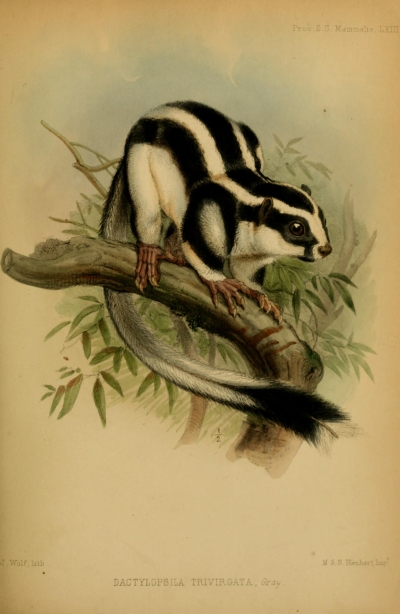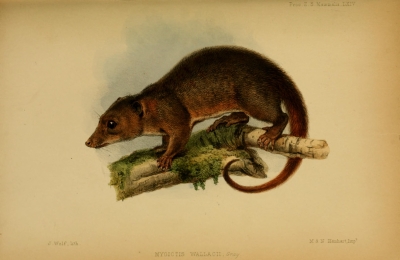4. LIST OF SPECIES OF MAMMALIA SENT FROM THE ARU ISLANDS BY MR. A. R. WALLACE TO THE BRITISH MUSEUM. By DR. J. E. GRAY, F.R.S., V.P.Z.S., PRES. ENT. SOC., ETC.
(Mammalia, Pl. LXIII. LXIV.)
Mr. A. R. Wallace has lately sent to Mr. Samuel Stevens a collection of Mammalia and Birds from the Aru Islands, referred to in his paper on the Natural History of those islands in the 'Annals and Mag. Nat. Hist.' 1857, which has been transferred to the British Museum, and forms a most important addition to the collection of that establishment.
His list does not contain a single Bat.
In the 'Zoology of the Voyage of H.M.S. Samarang' I gave a list of the Mammalia which had up to that period been found in New Guinea (p. 31); and in Dr. Müller's 'Verhandlingen' is a similar list.
Besides the animals sent home by Mr. Wallace from the Aru Islands, there are recorded in these lists—
1. DENDROLAGUS URSINUS. B.M.
Dendrolagus ursinus, S. Müller, Verh. 131, 141. t. 19. f. 22, 23.
Hypsiprymnus ursinus, Temm. Faun. Japan.
2. DENDROLAGUS INUSTUS. B.M.
Dendrolagus inustus, S. Müller, Verh. 131, 143. t. 20, 22, 23.
3. DORCOPSIS ASIATICUS. B.M.
Dorcopsis Brunii, Müller, Verhand. 131.
Dorcopsis Asiaticus, Gray, Voy. Sam. 32.
Filander or Kangaroo, Le Brun's Voyage, i. 347. t. 213, 1714.
Didelphis Asiaticus, Pallas, N. A. Petrop. 1777, 228. t. 9.
D. Brunii, Gmelin.
Halmaturus Brunii, Illiger, Prod.
Hypsiprymnus Brunii, Müller, Verh. 63. t. 21–23.
Island of Aru.
It is curious that this animal, described as specially inhabiting the island visited by Mr. Wallace, was not sent home by him. It is to be hoped that he did not neglect it, thinking it a common Kangaroo, as it is a desideratum in most museums in Europe.
The specimen of this animal in the Leyden Museum is said to be from the continent of New Guinea, where the two species of Dendrolagus and the Antechinus melas were also found.
4. PHASCOGALE (ANTECHINUS) MELAS.
Phascogale (Antechinus) melas, Müller, Verhand. t. 25. f. 1–3.
From New Guinea.
Differs according to the figure in having the hair of the tail rather
more elongated and spreading than the Australian species of the genus; the dentition is more nearly allied to the Antechinus than to the new genus Myoictis sent home by Mr. Wallace.
5. HALICORE AUSTRALIS. B.M
Halicore Australis, Owen in Jukes's Voyage of the Fly, ii. 323. f. 135, 1847; Gray, Voy. Samarang, 33.
Hab. Timor Straits.
6. SUS PAPUENSIS.
Sus Papuensis, Lesson, Voy. Coquille, t.; Müller, Verh. t.
Hab. New Guinea. Called 'Bene.'
A species which has not yet reached England.
The following animals sent home by Mr. Wallace do not occur in the list; indeed it does not contain a single Bat: viz.—
1. Hipposideros Aruensis.
2. Pteropus argentatus.
3. Dactylopsila trivirgata.
4. Myoictis Wallacii.
VESPERTILIONIDÆ.
1. PTEROPUS ARGENTATUS. B.M.
Back white, with scattered black hairs; beneath yellowish; face grey, nakedish; head deeper yellow-grey, with black interspersed hairs; collar broad, bright red-chestnut, darker brown at the sides and under side, where the hair is longer, forming a kind of ruff; ears and membranes (when dry) black.
Hab. Aru Island. Female.
"Back of a silky or silvery shining white, very beautiful in the freshly killed animals." — Wallace.
HIPPOSIDEROS.
As M. Bonaparte has given the name of Phyllorhina to the European Horse-shoe Bats, I am inclined to restrict the genus Hipposideros to those species of the larger genus which have a large cavity opening with an expanding pore on the forehead behind the transverse hinder part of the nose-leaf; they have distinct pubal teats; thus restricting Phyllorhina to those which have a simple forehead without any pore.
2. HIPPOSIDEROS ARUENSIS. B.M.
Sooty-brown; the lower half of the hairs of the back paler; the hairs of the under side more uniform, or with rather paler tips; the ears large, broad, rounded at the ends, with two hairy lines on the inner side of the front edge; face and chin rather bristly, without any membranaceous ridges on the sides outside of the nose-leaf.
Hab. Aru Islands. "Male." — Wallace.
Length of head and body 2"; tail ⅝; expanse of wings 5¼; length of upper arm bone 1½; length of shin bone ⅝ inch.
The ears sooty-black; the front margin of the ears is broad, with a rounded lobe on the basal part near the forehead; wings broad, thin, sooty-black, bald; thumb slender, of two subequal joints; the interfemoral membrane broad, truncate at the end; the hind legs slender, rather elongate; feet slender, enveloped in the membrane to the base of the slender equal compressed, toes; the heel-bones elongate, longer than the foot; tail elongate, slender, attached and extending a little beyond the end of the truncated interfemoral membrane.
Cutting teeth 1—¼ upper large, chisel-shaped, separated by a small space from each other and from the canines; the lower small, crowded, three-lobed; canines conical; grinders ——?
The specimen is unfortunately rather injured about the face; but it appears quite distinct in form from any of the Horse-shoe Bats I have hitherto observed.
This species appears to be quite distinct from Hipposideros speoris of Timor, which is described as being a little larger than the larger English Horse-shoe Bat,Phyllorhina bifer; it has the following synonyma:—
Vespertilio speoris, Schneid. in Schreb. Saugth. t. 59; B. Shaw, Zool. i. 147.
Rhinolophus marsupialis, Geoff. Cour. 1805.
Rhinolophus speoris, Geoff. Ann. Mus. xx. 261. t. 5. 266; Desm. N. D. H. N. xl. 368; Mam. 126; Fischer, Mam. 139.
Rhinolophe cruménifère, Péron & Lesueur, Voy. aux Terres Aust. Atlas, i. t. 35.
Hab. Timor (Péron and Lesueur).
It is certainly distinct from Hipposideros insignis, Gray, Mag. Zool. & Bot. ii. 492, the Rhinolophus insignis, Horsf. Java, Vesp. cyclope, Deschamps, MSS., from Java, which Fischer confounded with the former, and which has acute ears on the sides of the face, numerous lamellae under the front part of the nose-leaf, and is 13½ inches in expanse of wings.
Fam. KANGEROIDÆ.
3. CUSCUS MACULATUS.
Phalanger, male, Buffon, H. N. xiii. t.11.
Phalangista maculata, Desm. N. D. H. N. xxv. 473; Quoy & Gaim. Voy. Astrol, t. 7.
Cuscus maculatus, Lesson & Garnot, Voy. Coq. Zool.
Cuscus macrourus, Lesson & Garnot, Voy. Coq. Zool. 150. t. 4.
Grey or black and white, variegated, without any dorsal streak.
Hab. Aru Island.
Two skulls, male.
The specimen sent is white, with scattered black spots, more abundant on the middle of the back and sides.
4. CUSCUS ORIENTALIS. (Pl. LXI.)
Cuscus Quoyii, Lesson, Mam. 220.
♀ Phalangista Quoyii, Quoy & Gaimard, Voy. Uranie, Zool. 38 (t. 6 ? ?).
P. maculata, part., Waterhouse, Mamm. i. 274.
P. Papuensis, Desm. Supp. 341.
Brown, grizzled, with a few white-tipped hairs, with a narrow black dorsal streak.
Hab. Aru Island."Female," young.
5. BELIDEUS ARIEL.
Belidea Ariel, Gould, Proc. Zool. Soc. 1842, x. 11.
Pelaurus sciureus, Müller, Verhand. tabl.
Hab. Aru Island.
Female adult, with one young in the pouch.
DACTYLOPSILA.
Tail elongate, slender, depressed, densely clothed with fur, with the exception of the under side near the tip, which is bald and callous, the end rather bushy. Ears elongate, rounded, bald, except at the outer sides of the base. Pupil round? The fore-feet elongate; toes very slender, compressed, very unequal in length, quite free; the outer and third or middle toe nearly equal, the second or ring-finger much the longest, the fourth and fifth short, the fifth or innermost the shortest. The hind-feet slender, toes compressed, the two outer toes elongate, nearly equal, the two inner about half the length and united.
Skull (figs. 1,2,3) depressed, very broad, with very large expanded zygomatic arches; the face narrow, compressed and nearly erect on the side, tapering in front; the palate is narrow, concave. The cutting teeth 4—4/4—4; the upper front elongate, projecting in front, rather tapering and truncated at the tip; the second and third compressed, chisel-shaped, close together and to the front; the second small, the third larger; the fourth separated from the others by a small space and placed on the intermaxillary suture, compressed, curved rather like a canine; the lower front very long, projecting in front, curved, rather tapering at the tip; the second, third and fourth small, truncated, separated from each other, the second largest close to the base of the front tooth; the third small, separated from the second by a small space; the fourth very small, far from the other; and at the base of the front edge of the first grinder, in the space between the third and fourth on the right side of the jaw, is a cavity which appears to have been filled with a tooth like the third one, but there is no appearance of the tooth or cavity on the other side. Canines? 1—1/0—0, upper small, compressed, conical, tapering like, but smaller than, what I have called the hinder cutting teeth (fig. 3). Grinders 5—5/4—4, small, in two nearly straight lines parallel to each
other, and the hinder ones in each jaw rather smaller than the front ones; the front upper small, triangular; the others are four-sided and square, with four tubercles, the outer front tubercle of the second tooth being rather larger than the rest, which are nearly equal among themselves, and the front lower grinder has only one larger tubercle in the place of the two in the others (figs. 4, 5).
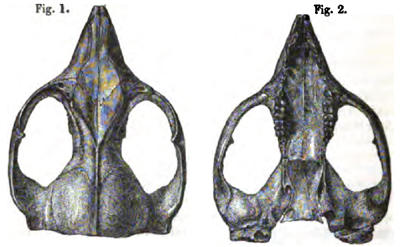
This genus is very distinct from the other genera of Phalangistina, in the elongated and depressed form of the tail, the formation of the fore-feet, and especially in the disposition and form of the teeth, as well as in the broad depressed skull.
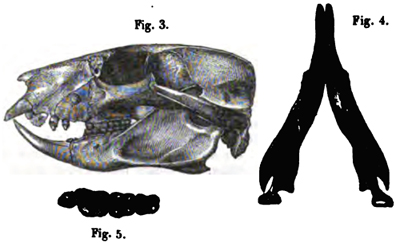
The following observations may assist in showing the value of these characters.
In Cuscus the fingers are rather longer than in Hepoona, and the third or middle finger is the longest, the others becoming gradually shorter on each side.
In Phalangista proper (that is Trichosurus of Mr. Waterhouse) the fingers are moderately long, the second and third are the longest and equal, the fourth longer than the first, and the fifth or inner one the shortest.
The hand of the Hepoona is very like that of Phalangista, both in the proportion and form of the fingers; but the two inner fingers are rather separated and opposible to the other three.
The tail though covered with hair is very unlike those of the genera Hepoona and Phalangista, and is more like that of a squirrel, but not SO bushy; in Hepoona it is tapering and covered with shortish hair, and has a slender tip; in the more perfect specimen of Phalangista it is cylindrical and equally covered with hair on all sides.
In Hepoona and Phalangista the grinders are placed in arched series, and they are much larger compared with the size of the skull than in this genus, and the hinder grinders are larger than the front ones; the front grinder in the upper jaw is larger, more elongate, and compressed.
6. DACTYLOPSILA TRIVIRGATA (Pl. LXIII.).
White; three broad black stripes on the back, the outer ones commencing on the side of the nose, enclosing the eyes, and continued along the side of the back; the central one commencing on the crown and continued to the end of the tail, being narrower at the base of the tail: a large black square spot on each side of the chin, separated by a narrow central line; a large spot on the upper surface of each leg; the sides of the throat are greyish, and the sides of the body are rather greyish from the dark colour of the base of the fur on that part of the body; the tip of the tail is whitish, and the under part of the upper surface near the tip, with a narrow streak ending some way down the middle of the under side of the tail, black; the under side of the tip of the tail is bald, without hair, but scarcely callous; the feet flesh-coloured, with few scattered short whitish hairs; the ears nakedish, black when dry.
Hab. Aru Island.
A female: lives on fruit. "Teeth 20/18." (Wallace.)
MYOICTIS.
Head tapering; nose acute; whiskers strong. Tail depressed, tapering, clothed with rather elongated hairs above and on the sides; the under side flat, nakedish. Feet moderate; soles bald to the heel; toes 5•5, free, compressed; claws acute; first and fifth front toes equal; second, third and fourth toes equal, longer; hinder toes free, weak, distinct, clawless; thumb of hind-foot larger. Ears roundish, nakedish. Scrotum pendulous.
Cutting teeth 4—4/6; the upper with a central space in front between them, in a close series on each side, and with a small interspace between them and the canines; the first tooth very small, hid in the gums, the others all equal, lancet-shaped, rather crowded; the lower
forming a continued series, shelving forward, all lancet-shaped, sub-equal; the front rather the longest and narrowest; the hinder rather broader.
Canines 1—1/1—1, conical; the upper not quite developed, only slightly produced above the level of the other teeth; the lower small, conical, scarcely raised above the other teeth (figs. 3, 4)
Grinders false,2—2/2—2, conical, compressed; the lower with a very obscure, the upper with a rather more distinct, conical tubercle on the front and hinder edge (figs. 3, 4).
The true grinders 2—2/3—3; the upper large, triangular, acutely lobed; the lower compressed, very acutely lobed; the middle one in each jaw the largest.
The angle of the lower is produced, elongate and strongly inflexed, as is usual in Marsupialia.
Skull: length, 1 inch 3 lines; width, all the zygomatic arch, 9 lines; length of the tooth-line 9 lines. Length of the lower jaw 11½, of symphysis 4½, of tooth-line 7½ lines (figs. 1,2,3,4).
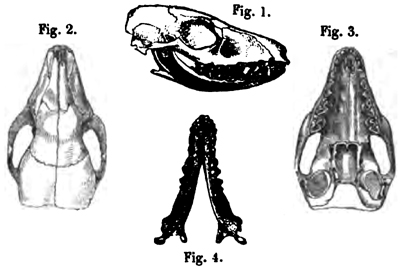
This genus is peculiar, because, as far as the dentition is concerned, there is no character by which we should have determined that it was a Marsupial animal; but the form of the angle of the lower jaw at once shows its true affinity to that group. It was not until a most careful examination of the space between the front upper cutting teeth, that I could find any indication of the front pair of cutting teeth found in the allied genus Antechinus.
This genus is evidently allied to the genus Antechinus of Australia; but it is known at once by its external form, which is just that of a small Indian Herpestes or Ichneumon, having like that genus a depressed tail with long spreading hair, broad and depressed at the base, tapering to an acute tip which bears a pencil of hairs.
7. MYOICTIS WALLACII (Pl. LXIV.).
Rusty-brown, with interspersed black longer hairs; head redder; throat, chest and belly pale reddish; side of the neck at the base of
the ears bright reddish; ears, and the greater part of the tail bright red-brown; tip of the tail black.
Hab. Aru Island.
Male.
" In houses as destructive as rats to every thing eatable.
" Teeth 34:— Inc. 6/6 C. 1—1/1—1; Prem. 2—2/2—2; M. 2—2/3—3,"—Wallace.
8. PERAMELES (ECHIMIPERA) DOREYANUS.
Perameles Doreyanus, Quoy & Gaimard, Voy. Astrol. Zool.i. 100. t. 16. f. 1–5; Waterhouse, Mam. i.386.
Echymipera Kalulu, Lesson, Règ. Anim. 192.
Tail naked, rugose, squamose, wrinkled below. Toes 3.5: the two inner front large, equal; the outer small; the inner hind toe short, clawless; the two index fingers small, united, clawed.
Hab. Aru Island.
Female.
"The skin is very thin and friable.
"Teeth 46:—Inc. 8/6; C. 1—1/1—1; Prem. 3—3/3—3; M. 4—4/4—4."—Wallace.
This enumeration agrees with that given by MM. Quoy and Gaimard, being two cutting teeth in the upper jaw less than are found in the other species of the genus; hence Lesson considered it as a genus.
The outer and inner toes of the forefeet are very small, rudimentary and clawless.
9. PARADOXURUS HERMAPHRODITA.
Hab. Ké Islands.
Is in the collection: it only appears to be a variety of the very variable and extensively distributed Paradoxurus hermaphrodita.
5. DESCRIPTION OF APHROCERAS, A NEW GENUS OF CALCAREOUS SPONGIADÆ BROUGHT FROM HONG-KONG BY DR. HARLAND. BY DR. J. E. GRAY, F.R.S., V.P.Z.S., PRESIDENT ENT. SOC. ETC.
(Radiata, Pl. X.)
APHROCERAS.
Sponge tubular, branched, without any large superficial oscules, formed of two distinct coats, externally covered with simple fusiform calcareous spicula, placed side by side in the longitudinal axis of the stem and branches, forming an even coat; inner surface of the tube lined with a minute network of interlaced fibre placed in all directions; branches simple, tapering, attenuated at the tip, with a round terminal contracted aperture.
The spicula are entirely dissolved in dilute muriatic acid, leaving the form of the sponge marked by the internal network and the sheaths
No. CCCLIV.—PROCEEDINGS OF THE ZOOLOGICAL SOCIETY.
of the spicula on the surface. When treated with caustic potash, the internal network is destroyed, leaving only the external spicula placed side by side.
This genus is allied to Grantia, but it is easily distinguished by the uniform fusiform shape and the disposition of the spicula.
APHROCERAS ALCICORNIS. (Pl. X.)
Hab. Hong-Kong (Dr. Harland).
This species somewhat resembles Grantia botryoides in appearance and habit; but in that species the spicula are all triradiate, which appears to be the generic character of the genus Grantia as I propose to restrict it.
